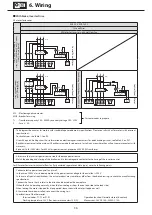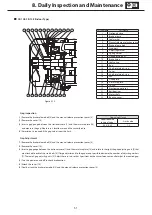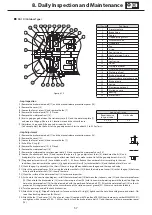
8. Daily Inspection and Maintenance
44
45
8-7 Brake Maintenance and Inspection
DANGER
- Do not handle the unit when cables are enregized. Be sure to turn off the power when working on the unit; otherwise, electric shock
may result.
- When using for lifting, do not release the brake while a load is suspended; otherwise it could fall, causing an accident.
- Do not operate the machine while the brake is released by the manual brake release bolt; otherwise, falling, going out of control, or
damage to the equipment may result.
- Before operation turn power on and off to check brake action; otherwise falling or running out of control could occur.
- Do not let water or oil touch the brake. the brake. Brake torque degradation could cause falling or running out of control.
CAUTION
- After gap inspection and adjustment do not operate with the fan cover removed; otherwise loose clothing may became caught in
these rotating parts and cause serious injury or death.
- Changing brake linings requires experience. Consult with the nearest authorized maintenance shop.
Given normal operation conditions, brake mechanical lifetime is quite long at 2 million times (1 million times for FB-30, ESB-250 and
ESB-250-2). These conditions include the moment of inertia for the load being no greater than the one for the brakemotor. How-
ever, please periodically inspect the brake gap (G). The brake lining wears after long hours of running time, making it impossible
for the brake to release. When 2 million times is exceeded (1 million times for FB-30, ESB-250 and ESB-250-2), wear and damage to
mechanical parts may cause dropping or overdrive problems.
8-8 Brake Construction and Gap Inspection and Adjustment
- The brake is spring activated (off brake type).
- The brake lining wears after long hours of operating the brake, making it impossible for the brake to release. Therefore please periodi-
cally inspect the brake gap (G).
- If on inspection the gap is close to the limit value, adjust the gap.
- In FB-1E - 4E a shock absorber is inserted between the stationary core and the armature plate to reduce the noise that results from the
braking action.
When inspecting, be careful that the gap gauge, other measuring tool or anything else does not damage the shock absorber or cause it
to fall out.
There is danger that if the shock absorber is damaged or falls out, brake noise will increase and the brake will not function properly.
Table 8-7 Pages Containing Information on Brake Construction and Gap Inspection and Adjustment
Brake Type
Indoor
Outdoor
FB-05A1
P45
P56
FB-1D
P46
P57
FB-1E
P47
P58
FB-1HE, FB-2E
P48
P59
FB-3E, FB-4E
P49
P60
FB-5E, FB-8E
P50
P61
FB-10E, FB-15E
P51
P62
FB-20
P52
P63
FB-30
P53
P64
ESB-250, ESB-250-2
P54
P65
Note: Please refer to P67 for the way to remove and install One-Touch Release lever.
















































